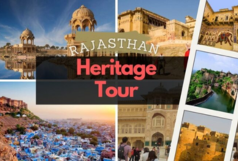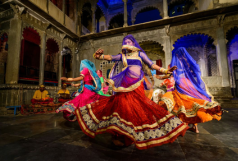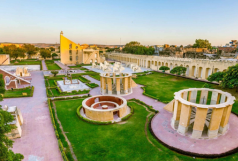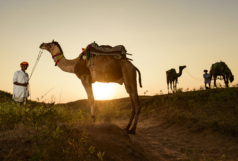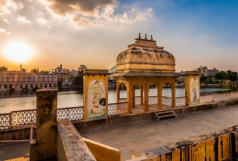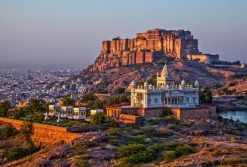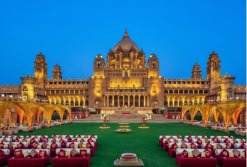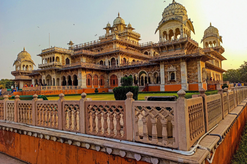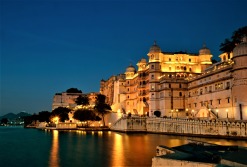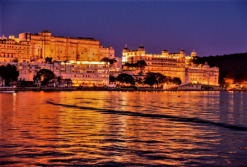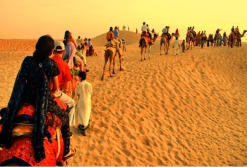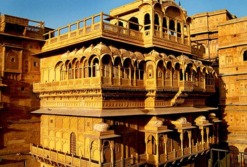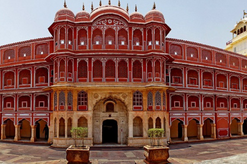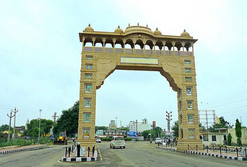Places to Visit in Jaipur
Known as the Pink City, Jaipur is a vibrant destination that blends royal history with modern allure. Whether you're here to marvel at the stunning architecture, soak in the culture, or explore its bustling bazaars, the city has something for everyone. From grand palaces and majestic forts to tranquil gardens and ancient temples, the capital of Rajasthan is a treasure trove of history and culture. In this blog, we’ll take you through the top places to visit in Jaipur, providing a comprehensive guide to help you plan your Jaipur sightseeing tour.
Amber Fort
The Amber Fort (or Amer Fort) is one of Jaipur’s most iconic landmarks and a UNESCO World Heritage site. Located around 11 kilometers from the city center, this massive fort is built of red sandstone and marble, showcasing a perfect blend of Hindu and Mughal architecture. Visitors can take an elephant ride up the hill to the fort’s entrance, or hike up to admire its stunning structures, including the Sheesh Mahal (Palace of Mirrors), Diwan-e-Aam (Hall of Public Audience), and Sukh Niwas.
City Palace
Located in the heart of Jaipur, the City Palace is an exquisite blend of Mughal and Rajasthani architecture. Built in the 18th century, it remains one of the most prominent tourist attractions in Jaipur. The palace complex houses several structures, including the Chandra Mahal, Mubarak Mahal, and Diwan-i-Khas. Each area of the City Palace is adorned with intricate carvings, grand courtyards, and beautiful gardens. The palace also features a museum that showcases royal costumes, weapons, and artifacts from Jaipur’s rich past.
Hawa Mahal
The Hawa Mahal, or the Palace of Winds, is one of the most recognizable landmarks in Jaipur. Built in 1799 by Maharaja Sawai Pratap Singh, this five-story palace was designed to allow royal women to observe the streets without being seen. The building's façade is made up of 953 small windows or “jharokhas,” through which the wind circulates, hence the name “Hawa Mahal.” Visitors can explore its corridors and catch panoramic views of the city from the top floors.
Jantar Mantar
Another UNESCO World Heritage site, Jantar Mantar is an astronomical observatory built by Maharaja Sawai Jai Singh II in 1734. It features the world’s largest stone sundial, along with various other instruments designed to observe celestial bodies. The Jantar Mantar is a testament to the scientific prowess of ancient India and remains a popular stop for tourists interested in Jaipur’s scientific and historical heritage.
Jal Mahal
The Jal Mahal, or Water Palace, is one of the most serene and picturesque places in Jaipur. Situated in the middle of the Man Sagar Lake, this palace appears to float on the water’s surface, especially during sunrise or sunset. While entry into the palace is restricted, visitors can take boat rides on the lake and enjoy the view of the palace against the backdrop of the Aravalli hills. It’s a perfect spot for photography and peaceful sightseeing.
Nahargarh Fort
Perched on the edge of the Aravalli Hills, Nahargarh Fort offers panoramic views of Jaipur and its surroundings. Built by Maharaja Sawai Jai Singh II in 1734, the fort was initially constructed as a defense mechanism but later became a retreat for the royal family. The fort's scenic location makes it a popular spot for both history enthusiasts and nature lovers. The Nahargarh Biological Park, located within the fort's premises, is home to several species of flora and fauna, making it a perfect blend of history and nature.
Albert Hall Museum
Albert Hall Museum is the oldest museum in Rajasthan, and its stunning Indo-Saracenic architecture is worth admiring. Built in 1876, the museum houses an extensive collection of artifacts, including paintings, ivory, metal sculptures, and crystal work. It’s an excellent spot for history buffs and those interested in learning more about the rich cultural heritage of Jaipur and Rajasthan.
Birla Mandir
The Birla Mandir, also known as the Laxmi Narayan Temple, is a modern architectural marvel built entirely from white marble. This beautiful temple is dedicated to Lord Vishnu and Goddess Laxmi and is a peaceful retreat from the hustle and bustle of the city. The intricate carvings on the temple’s walls depict scenes from Hindu scriptures, making it a must-visit for those interested in religious architecture.
Jaipur Markets
No visit to Jaipur is complete without exploring its vibrant markets. Jaipur is a shopper’s paradise, offering everything from traditional Rajasthani textiles and jewelry to handicrafts and pottery. Popular markets include Johari Bazaar, known for its precious gemstones and jewelry; Bapu Bazaar, famous for traditional textiles and footwear; and Tripolia Bazaar, which is the best place to buy bangles and brassware. Visiting these markets provides insight into Jaipur’s local culture and craftsmanship.
Galtaji Temple (Monkey Temple)
Located just a few kilometers away from Jaipur, Galtaji Temple is a prehistoric pilgrimage site nestled in the Aravalli hills. This temple complex includes several shrines, sacred kunds (water tanks), and pavilions. The temple is known for its large population of monkeys, which have earned it the nickname "Monkey Temple." Visitors can explore the stunning surroundings, take a dip in the holy water tanks, and witness beautiful sunset views.
Conclusion
Jaipur is a city that beautifully blends ancient royal heritage with modern-day vibrancy. Whether you're here for its majestic forts, grand palaces, serene lakes, or bustling bazaars, Jaipur has an endless list of attractions that will leave you enchanted. These top places to visit in Jaipur offer a glimpse into the rich history and cultural traditions of this remarkable city. If you’re planning a Jaipur sightseeing tour, make sure to include these iconic landmarks in your itinerary. Book your Rajasthan tour package today and experience the timeless beauty of Jaipur, the Pink City of India!

